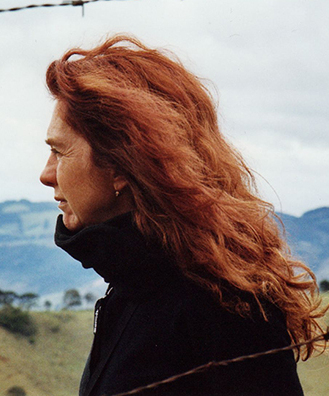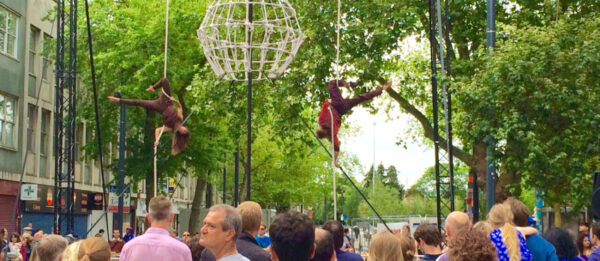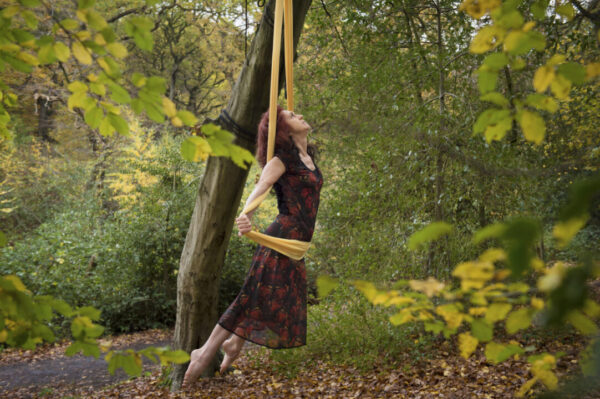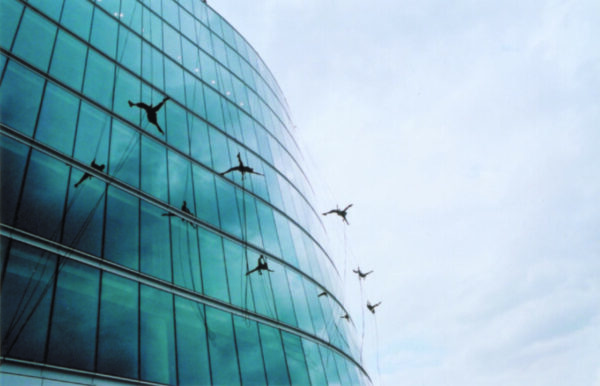Daniela Essert, Artistic Driector, Scarabeus Aerial

Daniela is the Artistic Director and co-founder (with Søren Nielsen) of Scarabeus Aerial. She trained in physical theatre, mask work and Commedia dell’Arte with Jacques Lecoq, Philippe Gaullier, Monica Pagneux and Carlo Boso from TAG Teatro. She has been directing and performing since 1984, with skills in stilt dancing, balance acrobatics, static trapeze, corde lisse and abseiling. She studied Theatre and Film Studies at the University of Turin and was awarded an MA in Performing Arts by Middlesex University. In 2015 she was a participant in the Clore Short Course Programme. (First published: April 2016).
How did you first get involved in Outdoor Arts?
In Italy, in my native city of Torino with TeatroTre – the company I co-founded. My first Outdoor Arts experience was a processional celebration on stilts. A few years later, in 1988, I met Danish performer Søren Nielsen; together we founded Scarabeus and it has been outdoors ever since.
What is one of your earliest memories of Outdoor Arts?
Søren and I performing Ballet-tico Fantastico, our first production together; a re-visitation of Swan Lake on stilts. We were touring Scotland and having a fantastic time. We were setting up in the village square of Pittenweem on the Fife coast and the place seemed deserted; suddenly at 7pm the square was full.
In our 5 years of touring Ballet-tico Fantastico, that was one of our best gigs ever. The audience was laughing, dancing and then crying when the characters were dramatically killed. After the show, as swiftly as they had appeared, the spectators moved off to the pier to see the fireworks. We met them an hour later, in the local pub for a lock-in with food and too much single malt whisky! It made me think about the magic of outdoor work, how we can transform a place into a performance space, and then return it back as it was.
What performance or Outdoor Arts experience has made a big impression on you?
Carmen Funebre by Teatr Biuro Podrozy, which was created by company members working with refugees from former Yugoslavia, after the Balkan war. The visual imagery was striking and the performers fierce. They delivered an uncompromising message about the brutality of war, blind extremism and intolerance.
Their illustration of the condition of displaced people was delivered with a mix of metaphors and poetry. We are now back there again, full circle – or has it ever stopped?
What’s the best artistic advice you’ve been given?
By one of my Lecoq teachers: when something unexpected happens while you are improvising or performing, don’t take it is as an accident; value it as a present and make the best of it.
Where do your ideas come from?
From books, paintings, visual imagery and contemporary issues that touch me and make me passionate. Once an idea has installed itself in my brain and my heart, there is no way to get rid of it. I will start to dream about it, plot how I can make it happen, think and think and think about it, until I start to give it life.
This process from injection to fruition tends to have a three-year cycle. So, by the time Scarabeus get the commissions and funding, the initial ideas may have transformed and metamorphosed into a different version of the original idea.
What’s your top tip to someone wanting to work outdoors for the first time?
Be adaptable, the outdoors can be quite an unforgiving environment but also one of the most rewarding. Be prepared for your audience to interact with you directly and maybe vote with their feet!
Do some research, go and see what is happening in the sector – other outdoor artists and companies are often of inspiration. Go and talk to them: the Outdoor Arts sector tends to be quite friendly and unpretentious.
Perhaps shadow an artistic director; or volunteer for a season with a company that you find inspiring. You may want to dream big – however, be realistic and start small. Become knowledgeable of what is possible to achieve.
Last, but not least… make sure you invest in warm clothing and a good waterproof!
What’s your funniest or most bizarre Outdoor Arts experience?
In 28 years we have collected a few of them – I could not choose between two of our best!
In 1993 our production Fata Morgana – Vision of the Skywalkers, was booked by a music festival in Germany. Our technical specification clearly stated that we were performing acrobatics on stilts and we needed a flat surface, no wet grass, cobblestones or gravel. We arrived after hours of travel in a not so comfortable van and discovered that the site where we were performing was covered in gravel. However, with German precision, a number of volunteers were recruited by the organizers and in few hours the ground was entirely swept free of gravel! In the meantime, Les Sharpe of Emergency Exit Arts was preparing the fireworks that were part of our performance. It was a scorching day and Les kept meticulously waterproofing each item. We asked why he was doing that, and he answered that it was better to be prepared than sorry. Come evening time, there was a vast crowd gathered for the performance. As soon as the Skywalkers reached the performance space the soundtrack – which started with a thunderclap – started to play and lightning lit the sky, whilst much stronger thunder broke out, followed by the most dramatic thunderstorm. Because the ground underneath the gravel was quite porous, the water was absorbed quickly, so we managed to perform most of the show before it became too dangerous for us to continue. The audience witnessed (under their umbrellas) a most exciting spectacle, with real storm effects highlighted by theatrical lights whilst Les set off all of his fireworks…
 In 2002 we were creating a site-specific aerial performance for the opening of the new headquarters of a big bank in Hannover, in Germany. The building was all glass and steel, a state-of-the-art beautiful piece of architecture and we felt honoured to be asked to perform on it. We had a number of bizarre incidents – from computerised windows, which opened and closed randomly to a freak 20-minute storm that almost blew our performers and equipment off the roof. On the last day before the opening, just before our dress rehearsal, a window cleaner crate suddenly swung around the corner of the building wanting to clean the windows where we were supposed to rehearse. We informed our contact in the bank that they could either have clean windows or a performance for the opening; if we didn’t get to rehearse we wouldn’t be able to perform. Subsequently, one of the biggest German banks had to call an extraordinary board meeting to discuss window cleaning versus show rehearsal! Ten minutes later, a window opened and someone in a smart suit shouted something in German to the window cleaners, who promptly and happily retreated for a cup of tea whilst Scarabeus carried on with their dress rehearsal.
In 2002 we were creating a site-specific aerial performance for the opening of the new headquarters of a big bank in Hannover, in Germany. The building was all glass and steel, a state-of-the-art beautiful piece of architecture and we felt honoured to be asked to perform on it. We had a number of bizarre incidents – from computerised windows, which opened and closed randomly to a freak 20-minute storm that almost blew our performers and equipment off the roof. On the last day before the opening, just before our dress rehearsal, a window cleaner crate suddenly swung around the corner of the building wanting to clean the windows where we were supposed to rehearse. We informed our contact in the bank that they could either have clean windows or a performance for the opening; if we didn’t get to rehearse we wouldn’t be able to perform. Subsequently, one of the biggest German banks had to call an extraordinary board meeting to discuss window cleaning versus show rehearsal! Ten minutes later, a window opened and someone in a smart suit shouted something in German to the window cleaners, who promptly and happily retreated for a cup of tea whilst Scarabeus carried on with their dress rehearsal.
Describe a current project or future piece of work that you’re really excited about.
Scarabeus is currently working on a trilogy of work for all ages, created in consultation with young people. The second production in the trilogy, Depths of my Mind, is researched and developed in collaboration with neuroscientists from the NSPN U-Change study. It brings to life cutting-edge discoveries in neuroscience and neuro-imaging, concerning the latest studies on the teenage brain. Using suspended transparent platforms, Chinese pole and cocoons, we are exploring what it means to be changing, to feel different, lonely and searching for somewhere to belong. It will be touring in autumn 2016 – oh my God I will be banned if I say the word – indoors…
The last part of the trilogy, planned for 2017-18, will be Exodus. We want to research the effects of displacement in the minds and psyche of children and young refugees. We are aiming to translate this research into visual and aerial theatre workshops with young refugees (in collaboration with Migrant Help UK), which will inform and ultimately culminate in a raw and thought-provoking performance exploring concepts such as liminality, otherness and identity. It will be depicting a world where nothing is solid – tectonic plates shifting together and drifting apart. We are planning a performance that will divide a square in the middle, including the audience. We will create a land where crossing a border becomes an act of heroism and the audience will have to decide who can be accepted from the floating boats and who is destined to drown. It will be a fearless and unflinching outdoor production.
What do you think are the opportunities available now for the sector?
The opportunities in the sector are now wider and better than when we started, 28 years ago. There are creation spaces dedicated to the conception and making of outdoor work, commissioning opportunities and seed funding. A higher number of outdoor festivals are now commissioning new work, and music festivals are increasingly booking outdoor pieces.
Outdoor Arts reach areas and communities that venue based art-forms are unable to touch; this fact should also attract sponsorship from the commercial sector as an opportunity to invest in local communities.
Where do you think the sector will be in 4 or 5 years?
Although the Arts Council has stated there will not be an increase in arts funding, the government’s White Paper clearly stresses the importance of art being accessible. This theoretically should attract more attention to our sector, which has a long-standing proven record of serving non-theatre goers and communities who normally don’t engage with the arts. This could further inspire venues, galleries and museums to look for new and non-traditional performance platforms, and open up opportunities for collaborations and partnerships with the outdoor sector.
What do you see as the biggest challenges and how do you plan to meet them?
The general lack of investment and the knock-on effect that this has on our local authorities, venues and festivals who are our bookers and commissioners. The lack of funding towards large productions and the market to absorb it. We seem to be asked to produce mainly in small and medium-size. We continuously are under the pressure of having to forge partnerships that endorse the validity of our work.
Whilst this work modality has a lot of advantages, I wonder if it still gives the artists freedom to think out of the box, or if we are nurturing a risk-averse culture, where there will be less left-field artwork. I think it is important that we keep asking and challenging ourselves about why we work in the outdoor sector and what we want to express with our art form. Outdoor Arts are not just about entertainment, they are a political act.

Who inspires you in your work?
I am inspired by the collaborators we work with, by our dream teams that are prepared to bring the work to the highest level, share expertise and knowledge, rather than egos.
I tend to be inspired by artists who have integrity, who work with clarity and intuition and are not scared to create work that is intellectually rich, thought-provoking and edgy. I also like quirky, off the walls ideas and artists who break the mould, push boundaries and create new forms of expression. I love work that moves my heart.
My iconic sources of inspiration are Peter Brook, Robert Lepage and Pina Bausch.
How do you follow what’s happening in the Outdoor Arts and cultural sectors – what blogs, tweeters, websites, organisations do you recommend?
Of course, I religiously read the OutdoorArtsUK newsletter, which features a wealth of info and opportunities for our sector. I check the Without Walls website, Circostrada & HorsLesMurs, In Situ. We are subscribed to the National Centre for Circus Arts newsletter, Circus Futures, Arts Professional and Free Word, to mention a few. I check out websites, newsletters and Facebook pages of companies I like or have come to my attention.
What’s a favourite book/film/concert that you’ve encountered in the past 2 years?
I love reading and going to the cinema. My favourite book in the past 2 years is Burial Rites by Hannah Kent, who tells the story of Agnes, the last woman who was beheaded in Iceland in 1892. Kent, an Australian writer who travelled to Iceland, came across this real case and become obsessed with it, writes beautifully and has a real urgency in telling us this story. Agnes is one of the most compelling and lyrical female characters I have come across for quite a long time. One day I will create a performance inspired by this book, or make my first film…
Watching Leonard Cohen in concert on DVD made my heart sing – what an intelligent showman!
My favourite film, hmmm… a difficult choice: Only Lovers Left Alive by Jim Jarmusch made my heart melt. Recently re-watching Ulysses’ Gaze by Theo Angelopoulos reminded me of why we make art (never mind how high is the price we pay for it) and Pride made me laugh and cry, brought a spring in my step and the urge to take to the streets once again.
Think – act – perform – protest – subvert – make a point – re-think – re-imagine – start all over again. Isn’t it all part of the same act?



